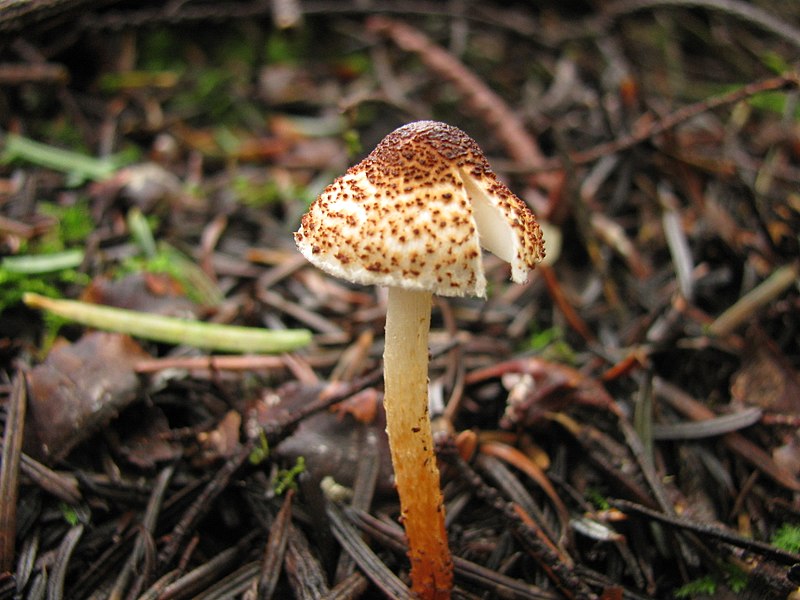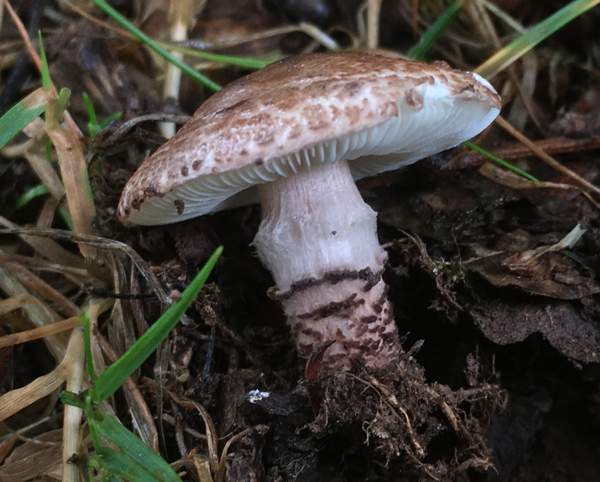Parasol Mushroom (Macrolepiota procera):
- a very wide gilled mushroom, white gills
- grows in grassland in middle of the summer
- scaly cap and, importantly, a scaly stem (snake-like skin)
- a nipple like in the center top of the cap
- whitish mycelium at bottom of the stem
- a ring that unusually can go up and down the stem if you moved it.
- overall this mushroom is not recommended for beginners, due to deadly lookalikes
Lepiotoid mushrooms were once all groups in the Lepiota genus, but nowadays they are divided in several genus (Lepiota, Macrolepiota, Cystolepiota, Leucoagaricus, Leucocoprinus and Chlorophyllum). Almost all have white spores, ring and saprobiotic (growing in plant litter, rather than associated with tree roots). Identification of species level is very difficult even for experts.
In general, the lepiotoid mushrooms (of which the parasol mushroom is part of) are poisonous. Never eat small lepiota mushrooms.
Lookalikes:
Shaggy Mushroom (Macrolepiota or Chlorophyllum rhacodes), which can cause tummy trouble in some people, it is very similar to the parasol mushroom, but the stem is not scaly, and the size is smaller.
Chlorophyllum molybdites, false parasol or green spored parasol, it is similar, but again it is without the scally stem (and the gills and spores are pale green in adult specimens, but still white when young). It causes poisoning with severe gastrointestinal upset. It tends to have a much less scaly cap.
Amanitas can look very similar when young, and are deadly! So avoid picking parasols when young. Amanitas have lighter flakes on a darker surface, while Parasols have darker flakes on a ligher surface! Parasols have a central knob and regular scale patterns. Parasols also lack the volva from amanitas but they still have an enlarged base. Both have white spores.
Cystoderma amianthinum, saffron parasol. Also scaly stem, but the overall color is diferent. Much more of a dark yellow, instead of the black-brown snaky pattern from the parasol mushroom.
Lepiota castanea, deadly!, stem without scales and much smaller size (about 3cm wide).
Lepiota brunneoincarnata, deadly dapperling, also deadly, also growing in grass, again much smaller (about 4cm wide), despite the very similar appearance to the parasol mushroom! Stem has less scales. Confusion with the edible fairy ring champignon Marasmius oreades and with the very common Agaricus bisporus.
Disclaimer: this is only intended for educational purposes. Do not eat mushrooms based on the information found here. In general, do not eat mushrooms unless you are 100% sure about its ID.
- a very wide gilled mushroom, white gills
- grows in grassland in middle of the summer
- scaly cap and, importantly, a scaly stem (snake-like skin)
- a nipple like in the center top of the cap
- whitish mycelium at bottom of the stem
- a ring that unusually can go up and down the stem if you moved it.
- overall this mushroom is not recommended for beginners, due to deadly lookalikes
Lepiotoid mushrooms were once all groups in the Lepiota genus, but nowadays they are divided in several genus (Lepiota, Macrolepiota, Cystolepiota, Leucoagaricus, Leucocoprinus and Chlorophyllum). Almost all have white spores, ring and saprobiotic (growing in plant litter, rather than associated with tree roots). Identification of species level is very difficult even for experts.
In general, the lepiotoid mushrooms (of which the parasol mushroom is part of) are poisonous. Never eat small lepiota mushrooms.
Lookalikes:
Shaggy Mushroom (Macrolepiota or Chlorophyllum rhacodes), which can cause tummy trouble in some people, it is very similar to the parasol mushroom, but the stem is not scaly, and the size is smaller.
Chlorophyllum molybdites, false parasol or green spored parasol, it is similar, but again it is without the scally stem (and the gills and spores are pale green in adult specimens, but still white when young). It causes poisoning with severe gastrointestinal upset. It tends to have a much less scaly cap.
Amanitas can look very similar when young, and are deadly! So avoid picking parasols when young. Amanitas have lighter flakes on a darker surface, while Parasols have darker flakes on a ligher surface! Parasols have a central knob and regular scale patterns. Parasols also lack the volva from amanitas but they still have an enlarged base. Both have white spores.
Cystoderma amianthinum, saffron parasol. Also scaly stem, but the overall color is diferent. Much more of a dark yellow, instead of the black-brown snaky pattern from the parasol mushroom.
Lepiota castanea, deadly!, stem without scales and much smaller size (about 3cm wide).
Lepiota brunneoincarnata, deadly dapperling, also deadly, also growing in grass, again much smaller (about 4cm wide), despite the very similar appearance to the parasol mushroom! Stem has less scales. Confusion with the edible fairy ring champignon Marasmius oreades and with the very common Agaricus bisporus.
Disclaimer: this is only intended for educational purposes. Do not eat mushrooms based on the information found here. In general, do not eat mushrooms unless you are 100% sure about its ID.





No comments:
Post a Comment